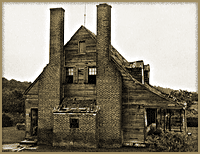







 |
 |
 |
 |
 |
| |
Did all enslaved people live on plantations?
Many enslaved people lived on large farms or plantations. They planted and harvested crops. Tobacco was an important crop in Maryland. Other enslaved people lived in towns and cities. Enslaved people lived in Annapolis, Baltimore, Easton, Frederick, and all of the towns across Maryland. Many lived on small farms. In addition to working in the fields, those who were enslaved often learned skilled crafts and worked as carpenters, blacksmiths, or builders. Others worked in mines and mills. Some worked as servants in wealthy people's homes. In towns, a few worked in shops, hotels, and other businesses.

Many enslaved people worked on plantations like this one in St. Mary’s County, Maryland.
|
Could any enslaved people read and write?
« back to Slavery and Free Blacks
|
|
 |
 |
 |
|
 |
|










